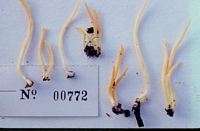|
 Clavaria phoenicea var. persicina Clavaria phoenicea var. persicina
BiostatusPresent in region - Indigenous. Non endemic
Images (click to enlarge)
Caption: Microfiche 1-8. Clavaria phoenica var. persicina. TENN no. 42379. | 
Caption: Microfiche 1-9. Clavaria phoenica var. persicina. TENN no. 43558. | 
Caption: 600, id. R. Petersen, label 50x10mm, NZ, NI, Omahuta, among litter and moss, mixed forest with
Leptospermum scoparium dominating, 15.05.1981, leg. EH
Owner: E. Horak |
Article: Petersen, R.H. (1988). The clavarioid fungi of New Zealand. New Zealand Department of Scientific and Industrial Research, Bulletin 236: 170 pp. Wellington:.
Description: Fruit bodies up to 8 cm high, up to 3 mm thick, simple clubs, narrowly fusiform to
cylindrical, scattered to gregarious or connate in pairs. Stipe slightly expanded at base, with
no discernible mycelial patch, off-white to "pale ochraceous salmon" at base, becoming more
apricot above ("light buff", "orange-buff", "light orange-yellow", "light ochraceous salmon"),
not well delimited from hymenium when fresh, more distinct when dry. Club opaque,
appearing waxy, buffy apricot to apricot ("capucine-buff", "capucine-orange", "light
ochraceous salmon", "orange-buff", "light orange-yellow", "seashell pink"), or pinkish
orange ("mikado-orange"), narrowing slightly above; apex rounded to narrowly rounded.
Odor and taste negligible.
Macro chemical reaction: FCL = negative or very pallid violaceous.
Tramal hyphae not significantly inflated, thin-walled, hyaline, parallel, tightly packed,
adherent to free, clamped. Basidia 40-50 x 6-8 µm, clavate, clamped; contents
multiguttulate when mature, the guttules concentrated at the distal end, and often with a large
guttule apical; sterigmata 4, stout, straight, somewhat divergent.
Spores 5-7.8 x 5-6.5 µm, globose to subglobose, smooth, thin-walled; contents opalescent to
uniguttulate; hilar appendix papillate, prominent.
Notes: The problems associated with these carotene-depositing taxa have been discussed by
Petersen (1979, 1985a). Several colour variants occur over the whole tropical and subtropical
range. The variant described above is the only one I have seen from New Zealand, and micro
morphologically it comes very close to Clavulinopsis sulcata van Overeem, at least in its
least pink state. It is also, in part, the taxon treated by me for south-eastern Australia as
Clavulinopsis amoena (Petersen 1970), and apparently occurs also in Tierra del Fuego
(Petersen, unpublished data). With such consistency of morphology, and of fruit body colour
(micro morphological constancy is taken for granted in this complex), I consider it
appropriate to propose the taxon as an apricot-coloured variety of C. phoenicea, the typical
variety of which is purple-red. After study of the type of Clavulinopsis sulcata van Overeem
(Petersen 1980), I do not consider them to be conspecific (cf. under Clavaria sulcata).
|